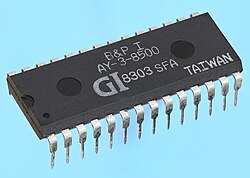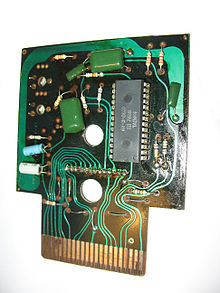|
AY-3-8500 The AY-3-8500 "Ball & Paddle" integrated circuit was the first in a series of ICs from General Instrument designed for the consumer video game market. These chips were designed to output video to an RF modulator, which would then display the game on a domestic television set. The AY-3-8500 contained six selectable games — tennis (a.k.a. Pong), hockey (or soccer), squash, practice, and two shooting games. The AY-3-8500 was the 625-line PAL version and the AY-3-8500-1 was the 525-line NTSC version. It was introduced in 1976, Coleco becoming the first customer having been introduced to the IC development by Ralph H. Baer.[1] A minimum number of external components were needed to build a complete system. The AY-3-8500 was the first version. It played seven Pong variations. The video was in black-and-white, although it was possible to colorize the game by using an additional chip, such as the AY-3-8515. Games
Six selectable games for one or two players were included: In addition, a seventh undocumented game could be played when none of the previous six was selected: Handicap, a hockey variant where the player on the right has a third paddle. This game was implemented on very few systems. Usage The AY-3-8500 was designed to be powered by six 1.5 V cells (9 V). Its specified operation is at 6-7 V and a maximum of 12 V instead of the 5 V standard for logic. The nominal clock was 2.0 MHz, yielding a 500 ns pixel width. One way to generate such a clock is to divide a 14.31818 MHz 4 × colorburst clock by 7, producing 2.04545 MHz. It featured independent video outputs for left player, right player, ball, and playground+counter, that were summed using resistors, allowing designers to use a different luminance for each one. It was housed in a standard 28-pin DIP. ApplicationsSome of the dedicated consoles employing the AY-3-8500 (there are at least two hundred different consoles using this chip[2]):
AY-3-8550The AY-3-8550 was the next chip released by General Instruments. It featured horizontal player motion, and a composite video output. It was pin compatible with the AY-3-8500. It needed an additional AY-3-8515 chip to output video in color. Games
Six selectable games for one or two players were included: UsageThe AY-3-8550 used the No Connect pins from the AY-3-8500, so it was possible to put an AY-3-8550 on an AY-3-8500 (without horizontal movement), and vice versa.  ApplicationThis is a list of consoles that use this chip: AY-3-8610 The AY-3-8610 was a major update from General Instruments. It played more games (10),[4] like basketball or hockey, with higher-quality graphics. It was nicknamed "Superstar" by GI. It was in black and white, although it was possible to add color by using an additional AY-3-8615 chip. Prior to producing the 8610, GI created the AY-3-8600. The pin configuration was the same as the 8610, but it was missing the two rifle/target games, bringing the total number of games down to 8. GamesThe 10 selectable games for this chip included:
UsageThe AY-3-8610 featured a completely different pinout. It, too, required an external crystal oscillator. It still had separate video output pins, and removed the dedicated sync pin.   ApplicationThis is a list of consoles that use the AY-3-8610:[2]
Some consoles that use the AY-3-8600 chip:[2] Derivatives 
See alsoReferences
External links |


